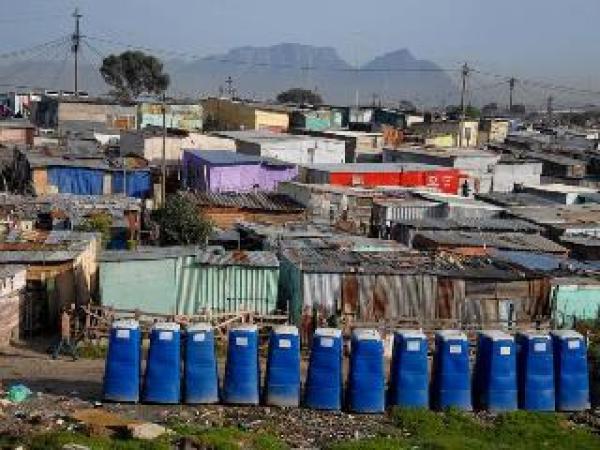

Photo by Masixole Feni.
21 May 2014
The Department of Science and Technology (DST) has launched an initiative to test new toilet technologies for South Africa’s rural areas.
South Africa’s water and sanitation challenges are plain to see – whether it’s an image of women walking kilometres with buckets on their heads, or Cape Town’s poorest resorting to outrageous acts of protest, sanitation cuts right to the heart of human dignity in this country.
This is why the DST announced a partnership with the Bill and Melinda Gates Foundation at the Reinvent the Toilet Fair in India last month.
The government has committed R30 million to the project, with an additional R10 million in support from the Gates Foundation. The toilets will be tested at rural schools in Cofimvaba, in the Eastern Cape, as part of a larger Technology for Rural Education Development Project (Tech4RED), as well as in 23 rural municipalities.
Henry Roman, Director for Environmental Services and Technologies at the DST, says that they are aiming to demonstrate some of the technologies that have emerged from the Reinvent the Toilet Challenge. Launched in 2011 by the Gates Foundation, the challenge provides funding to develop toilets that can convert human waste into valuable products such as energy, clean water and fertilisers. These toilets also need to work “off the grid” and cost less than 50c per user per day.
In a press release Brian Arbogast, the Director of Water, Sanitation and Hygiene at the Gates Foundation, says, “By applying creative thinking and new approaches to sanitation challenges, we can improve people’s lives. And we have no doubt that this new partnership with South Africa will help us achieve this. We believe that with governmental leadership, new business models and innovation, we can dramatically increase the progress made in tackling this global sanitation crisis,” he continued.
According to Roman, the department will evaluate 55 different types of toilet before choosing five to be tested over a two year period, alongside a local toilet technology produced by engineering company Maluti GSM.
“We would like to see that the demonstration technologies are applicable to a South African context,” Roman said. They will also work with the original designers (through the Gates Foundation) to adjust the designs where needed, and to train local service providers.
Despite government targets of universal access to sanitation by 2010, many South Africans still do not have access to basic facilities like a clean toilet. A UN report in 2011 showed that 74% of the South African population had access to hygienic toilets; that leaves nearly 13 million people without the safety and dignity of adequate sanitation. The project is trying to address this by focusing on rural communities where, according to the DST, the need is most pressing. Says Roman, “We are looking at people unlikely to get water-borne sanitation in the near future.”
An important part of the project is to involve the affected communities in the process. Speaking at the Reinvent the Toilet Fair in India, the sustainability manager at Kohler, Rob Zimmerman, is reported to have said, “Regardless of the technology developed, cultural acceptance of the solution is the key to its success.”
The importance of this concept is clear to see in previous attempts to provide sanitation in informal settlements: time and time again, a top-down approach without understanding the real needs of communities has resulted in poor acceptance of technology, or rapid failure through misuse of facilities.
So what about the nearly 10 million people living in informal settlements? For now, nothing will change. Henry Roman says that informal settlements are beyond the scope of the project. “We do understand the problems in informal settlements, but a completely different approach has to be taken.”
According to Councillor Ernest Sonnenburg, Mayoral Committee Member for Utility Services in the City of Cape Town (via the City’s media liaison), the challenges in informal settlements are complex. He says that innovative toilet technologies are not always suited to informal settlements because of regular flooding, high density living conditions, and land ownership problems.
Currently, the City of Cape Town provides communal chemical toilets and the much-maligned bucket toilets to informal settlements that do not have water-borne sanitation, as well as Afrisan “portaloos” to individual homes. But their claims of 100% sanitation to households in informal settlements do not hold up to scrutiny. An audit by the Social Justice Coalition in Khayelitsha last year found that many toilets were in a state of disrepair, and the service provider was not meeting its contractual obligations for maintenance and service of the chemical toilets. It’s one thing to install a new public toilet. Maintaining it is another big, perhaps bigger, challenge.
Providing dignified and hygienic toilets to the people of South Africa is clearly a long-term endeavour that needs input from a large number of government departments and private stakeholders. The DST plays almost no role in implementing any conclusions they may reach in this project. Rather, their findings will be communicated to other departments, which may or may not influence future policy decisions on how to best to provide rural South Africa with sanitation. So in spite of this new initiative, the government has a long way to go to reach their target of proper sanitation for all South Africans.
It’s a long walk to a clean toilet, it would seem.